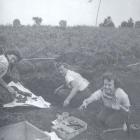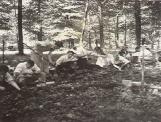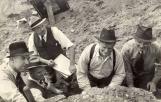1
Students excavating at field schoolcirca 1930's
London, Ontario, Canada
 Credits:
Credits:Museum of Ontario Archaeology
2
Prior to 1935 only a handful of prehistoric Iroquoian village sites in southern Ontario had been documented or professionally investigated by such notable researchers as David Boyle, Rowland B. Orr, George Laidlaw and Andrew Hunter. The first large-scale excavations of Iroquoian village sites were completed by William J. Wintemberg (1878-1941) for the Victoria Memorial Museum in Ottawa which later became the National Museum of Canada. Wintemberg's work atthe Roebuck, Uren, Lawson, Sidey-Mackay and Middleport sites between 1912 and 1930 provided important data that was used by later archaeologists to outline their temporal changes and cultural evolution of the Ontario Iroquoian Tradition through the Early (1000-1300 A.D.) Middle (1300-1400 A.D.) and Late (1400-1650 A.D.) Iroquoian stages.
3
Examples of stone and clay pipes found at the Clearville site1939
Municipality of Chatham-Kent, Ontario, Canada
 Credits:
Credits:Museum of Ontario Archaeology
4
In 1935 Elgin County historian and member of the Historic Sites and Monuments Board of Canada James Coyne succeeded in convincing the National Museum of Canada to conduct a major excavation of the well-known Southwold Earthworks, an important Iroquoian village west of St. Thomas. Wintemberg was the logical man to undertake such work, but he was plagued by ill health throughout his life and knew that he would need a capable assistant to look after the day-to-day fieldwork. Wilf and Wintemberg spent the better part of three months excavating Southwold, employing a crew of hired men with no previous field experience to do the manual labor. Despite that limitation, a major portion of the site was excavated. This fieldwork would prove to be highly significant as it was the first to completely expose a number of longhouses on an Iroquoian village. They also were the first to systematically map a set of Iroquoian defensive earthworks and palisades.5
Excavation at the Clearville site1939
Municipality of Chatham-Kent, Ontario, Canada
 Credits:
Credits:Museum of Ontario Archaeology
6
Wilf took the valuable lessons he had learned from Wintemberg and proceeded to complete his own excavations at other local sites, including the Mackenzie and Alway sites in Middlesex County in 1935-1936 and the Clearville site Kent County in 1939. In that same period Wilf also started teaching formal lessons on archaeology as part of the University of Western Ontario's summer school and extension classes in history. Part of his course work involved taking hisstudents on field trips to visit and excavate on local sites, including the Lawson site in July 1938. On many occasions Wilf returned to the Lawson site, located in what is now northwest London, Middlesex County. Wilf succeeded in convincing the Lawson family to donate the property to the University of Western Ontario to ensure long-term preservation of that site.
7
Students at field schoolcirca 1930's
London, Ontario, Canada
 Credits:
Credits:Museum of Ontario Archaeology
8
The Clearville project made a very significant contribution to archaeological knowledge since Wilf demonstrated that the village had three successive occupations. Clearville set important precedents which Wilf would utilize on all of his later projects. Foremost among these were his consultations with various faculty members at the University for inter-disciplinary studies such as the identification and study of soils, minerals, fish bones and human skeletal remains. He also learnt to cleverly engage the media, especially newspapers, to ensure frequent and extensive coverage of the dig and the objects being unearthed.9
Amos and Wilf at the Clearville Site1939
Municipality of Chatham-Kent, Ontario, Canada
 Credits:
Credits:Museum of Ontario Archaeology